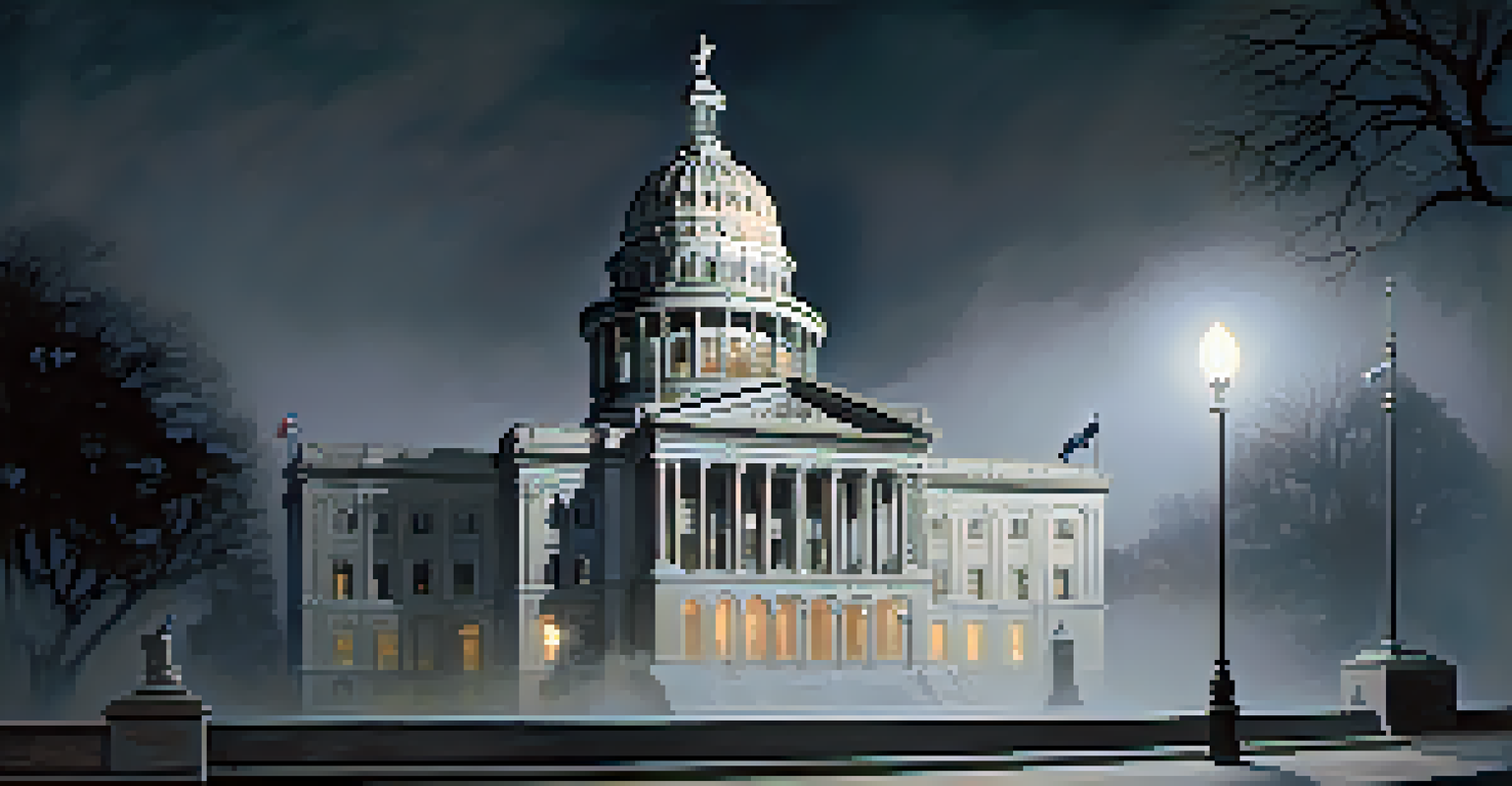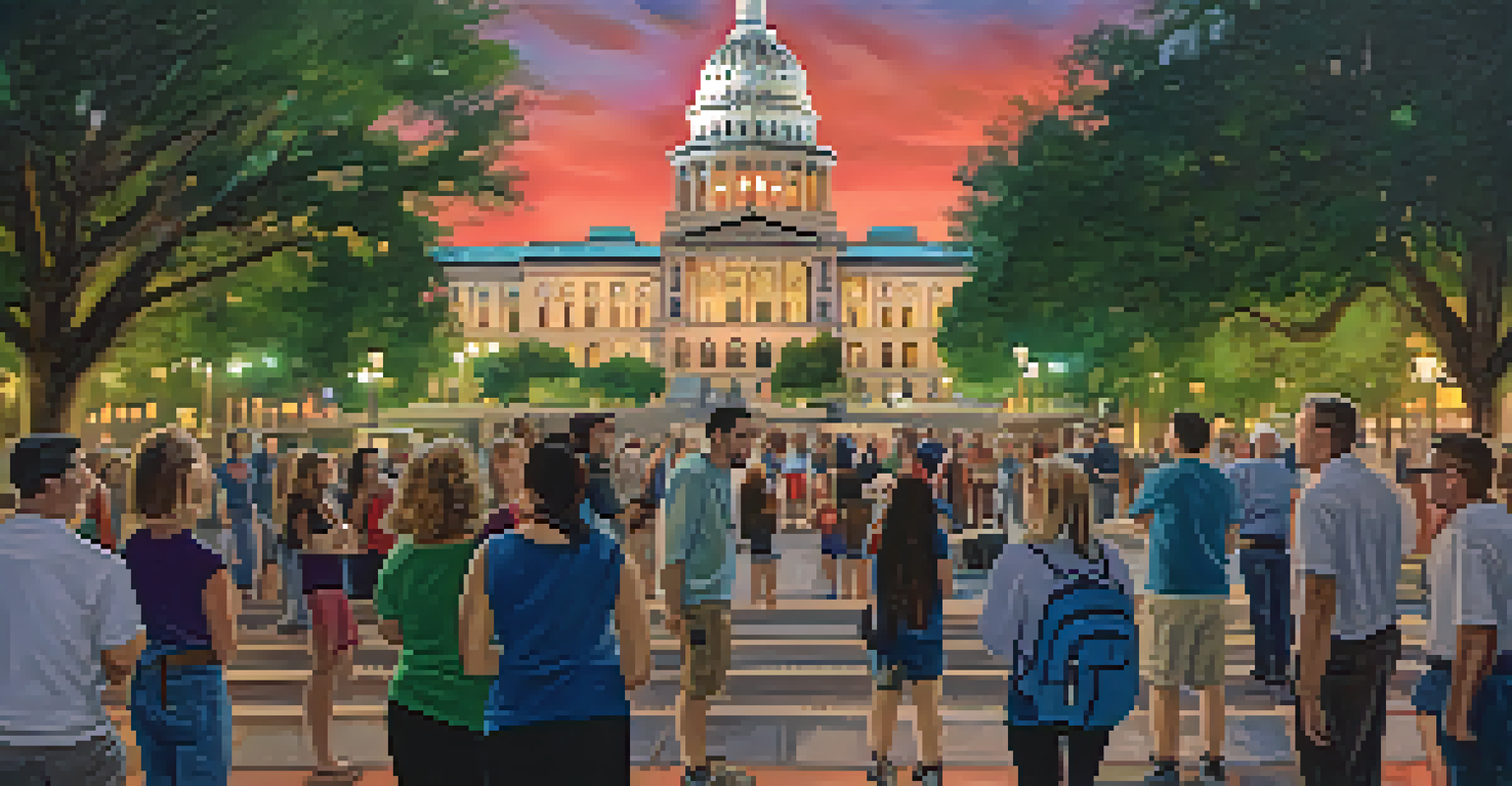Exploring the Myths of the Haunted Capitol of Texas

The Texas Capitol: A Historical Overview
The Texas State Capitol, located in Austin, is not only a hub of governance but also a treasure trove of history. Completed in 1888, this imposing structure is made from stunning pink granite, giving it a unique charm that attracts visitors year-round. The Capitol's architecture reflects the grandeur of the Texas spirit, but it also harbors tales that stretch beyond its impressive facade.
Ghosts are not only a part of our history; they are also a reflection of our collective consciousness.
As the largest state capitol building in the United States, its sheer size and beauty draw in tourists and locals alike. Yet, many are unaware of the darker stories that linger in its hallways and chambers. Over the years, various accounts and legends have emerged, hinting that the Capitol is home to more than just politicians and state officials.
Understanding the history of the Texas Capitol sets the stage for exploring the myths and legends that surround it. These tales often intertwine with the building's architectural features, creating a rich tapestry of both fact and fiction. Let's dive deeper into some of the more famous myths that continue to haunt this iconic landmark.
Ghostly Figures: The Legends of the Capitol
One of the most popular legends involves the ghostly figure of a former legislator who reportedly roams the halls. Many claim to have seen him during late-night sessions, pacing anxiously as if he is still awaiting a vote. This story has been passed down through generations, thrilling those who have a penchant for ghostly tales.

Another famous apparition is that of a woman in white, said to appear near the Capitol's staircases. Witnesses describe her as serene yet sorrowful, which adds an air of mystery to her presence. Some believe she is a spirit of someone who fought for Texas independence, forever lingering in a place that holds deep historical significance.
Texas Capitol's Haunted Legends
The Texas Capitol is steeped in ghostly tales and legends that enhance its historical significance.
These ghost stories not only entertain but also reflect the deep connections people have to the Capitol. They serve as reminders of the state's tumultuous history and the many lives that have shaped it, both in life and beyond. As we continue, it's essential to understand how these myths have evolved over time.
The Impact of Urban Legends on Tourism
Urban legends like those surrounding the Texas Capitol have a significant impact on local tourism. Ghost tours and haunted history walks have gained popularity, attracting thrill-seekers and history buffs alike. These tours often highlight the Capitol's haunted past, turning eerie tales into a fascinating experience for visitors.
Folklore is the living memory of a culture, a way for us to remember who we are and where we come from.
For many, the allure of the supernatural adds an exciting twist to their exploration of Texas history. Tour guides weave together facts and folklore, creating a narrative that captivates audiences. This blend of history and myth serves to enhance the overall tourist experience, making the Capitol a must-visit destination.
Moreover, the myths surrounding the Capitol foster community engagement. Local residents take pride in sharing their stories and experiences, contributing to a vibrant culture of storytelling. This sense of community not only enriches the visitor experience but also keeps the legends alive for future generations.
Famous Sightings: Encounters at the Capitol
Over the years, numerous visitors and staff have reported strange occurrences and sightings within the Capitol. Some have described feelings of unease or sudden drops in temperature, often associated with ghostly presences. These experiences have sparked curiosity and intrigue, prompting many to investigate further.
In one memorable incident, a security guard claimed to have seen a shadowy figure late at night, crossing the rotunda. This sighting was so vivid that it left him questioning the very nature of what he had witnessed. Such stories contribute to the Capitol's haunted reputation, inviting skeptics and believers alike to explore.
Tourism Boost from Urban Legends
The myths surrounding the Capitol attract tourists through ghost tours and haunted history walks.
These encounters highlight the enduring fascination with the supernatural, reminding us that even historical sites can have an air of mystery. Whether one believes in ghosts or not, these stories enrich the narrative of the Texas Capitol, transforming it from a mere building into a living part of Texas folklore.
The Role of Folklore in Texas Culture
Folklore plays a vital role in shaping Texas culture, with ghost stories being a significant part of that narrative. These tales not only entertain but also serve as a means of preserving history and tradition. By sharing legends like those of the haunted Capitol, Texans forge a connection to their past and to one another.
Many of these stories often reflect broader themes of courage, loss, and resilience, resonating with the state's spirit. They remind us of the trials and triumphs faced by those who came before us. In a way, these legends become a lens through which we can view Texas's complex history.
Moreover, folklore fosters a sense of community, as residents bond over shared stories and experiences. This cultural fabric enriches the state, making it a vibrant place to live and visit. As we explore the myths of the Capitol, we see how they weave into the larger tapestry of Texas folklore.
Debunking Myths: Separating Fact from Fiction
While the myths surrounding the Texas Capitol are captivating, it's essential to approach them with a critical eye. Many stories have evolved over time, with embellishments that may obscure the original facts. By examining historical records, we can separate the truths from the tales spun by time and imagination.
For instance, some ghostly encounters are often attributed to scientific phenomena, such as drafts or electrical issues that create eerie sensations. Others might stem from the natural wear and tear of an old building, leading to creaks and groans that fuel the imagination. Understanding these aspects can demystify some of the more sensationalized accounts.
Folklore Shapes Texas Culture
Folklore, including ghost stories, plays a crucial role in connecting Texans to their history and community.
Ultimately, while debunking myths can provide clarity, it doesn't diminish the enjoyment they bring. Engaging with these stories, whether as folklore or fact, allows us to appreciate the depth of our shared history. As we continue exploring, let’s consider how these myths contribute to the Capitol's enduring charm.
Visiting the Haunted Capitol: What to Expect
If you're planning a visit to the Texas Capitol, prepare for more than just a glimpse of its stunning architecture. Many tours offer insights into the haunted legends, providing a unique perspective on this historical site. Whether you're a believer or a skeptic, the stories shared by guides are sure to spark your imagination.
Visitors can expect to meander through the grand hallways, where tales of ghostly encounters echo in the air. The atmosphere is often charged with a sense of history, making it easy to envision the events that unfolded within these walls. As you explore, keep an open mind; you never know what you might experience.

In addition to the ghost stories, the Capitol also boasts impressive artwork and historical exhibits. This combination of the eerie and the educational makes for an unforgettable experience. So grab your camera and prepare for an adventure that blends history, folklore, and perhaps a little bit of the supernatural.